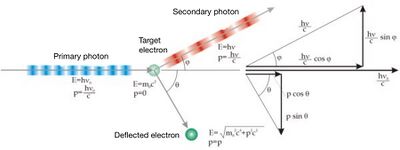Compton's phenomenon - what it proves and benefits
Compton effect[edit | edit source]
Compton effect (Compton scattering or incoherent scattering) is the interaction of a photon γ radiation with a free or weakly bound electron, during which part of the photon's energy is transferred to the electron. During this interaction, the electron acquires kinetic energy and starts to move in a direction deviated from the original direction of the path of the primary photon by an angle φ. The scattered photon (secondary photon) with lower energy (that is, with a longer wavelength) is deflected by an angle ψ. The event can be repeated several times until the photon loses so much energy that the probability of its extinction by the photoelectric effect prevails.

It mostly does not depend on the proton number of the material of the substance. It depends on the electron density (the number of electrons per cm 3 ).
Compton scattering is the predominant interaction at energies from 0.1 to 10 MeV.
What does the Compton effect prove[edit | edit source]
The Compton effect, or Compton scattering, cannot be explained on the basis of the wave properties of radiation (from this point of view, the wavelength of the scattered radiation should be the same as the original). It is therefore one of the phenomena proving the existence of the photon. The experiment proving the Compton effect also confirmed that photons can behave as particles as well as waves.
History and contribution[edit | edit source]
Compton scattering was discovered in 1922 by Arthur Holly Compton (1892-1962) while conducting research on the scattering of X-rays by particles of light. In 1922 he published his experimental and theoretical results and in 1927 received the Nobel Prize for this discovery. His theoretical explanation of the phenomenon now known as Compton scattering differs from classical theories and requires the use of special relativity and quantum mechanics, which were barely understood in his time. At first, his results were considered very controversial, but later his work was recognized and had a strong influence on the development of quantum theory.
Using the Compton effect[edit | edit source]
- Use in radiotherapy
- Compton scattering is used in radiotherapy (irradiation), where living matter interacts with high-energy radiation (gamma radiation , X-rays). When photons strike tissues, energy is lost in one of three ways: the photoelectric effect , Compton scattering, or the formation of electron-positron pairs. In clinical radiotherapy, the most common and therefore the most important of these mechanisms is Compton scattering, in which photons interact with valence electrons of tissue atoms. During such an interaction, photons are not only scattered but at the same time (thanks to the supplied energy) an electron is torn from the valence layer, i.e. ionization.
- The biological effects of radiotherapy consist of targeted damage to the DNA of e.g. tumor cells, which occurs either by direct ionization of DNA atoms or indirectly by the action of free radicals formed (primarily hydroxyl radicals formed by ionization of water molecules ).
- Use in spectroscopy
- The Compton effect is used in the detection of ionizing radiation. It is used in scintillation detectors to detect gamma rays.
- Use in astronomy
- Compton scattering is also used in astronomy. An example is the Compton Gamma Ray Observatory (Compton Gamma Ray Observatory, abbreviated Compton GRO or CGRO), this observatory took pictures of the most energetic processes in the universe, such as solar flares, gamma ray bursts, pulsars, nova and supernova explosions, black holes, etc. CGRO was equipped set of sensors, one of which was the Imaging Compton Telescope, COMPTEL), which used Compton scattering to study and analyze gamma rays in the energy range of 1 to 30,000,000 eV. This device made it possible to determine with great accuracy the direction and energy of the original gamma photon, as well as to reconstruct the image and energy spectrum of the source of the given radiation.
Links[edit | edit source]
Related articles[edit | edit source]
- The Compton effect - what does it consist of?
- Compton scattering
- Photoelectric phenomenon
- Wave-corpuscular dualism
External links[edit | edit source]
- Compton Gamma Observatory
- Compton Gamma Ray Observatory Science Support Center
- Principles of radiation therapy
- The Compton Effect - Compton Scattering and Gamma Ray Spectroscopy
- Compton effect (muni)
References[edit | edit source]
- Navrátil, Leoš; Rosina, Jozef a kolektiv: Medicínská biofyzika, 1. vydání, Praha, Grada, 2005 ISBN 978-80-247-1152-2
- Amler E, Blažek T, Heřmanská J, Koláčná L, Kotyk A, Vackářová J, Varga F. Praktické úlohy z biofyziky I. Ústav biofyziky UK, 2. lékařské fakulty, Praha, 2006
- Jeffrey A. Norton: Surgery:Basic Science and Clinical Evidence


